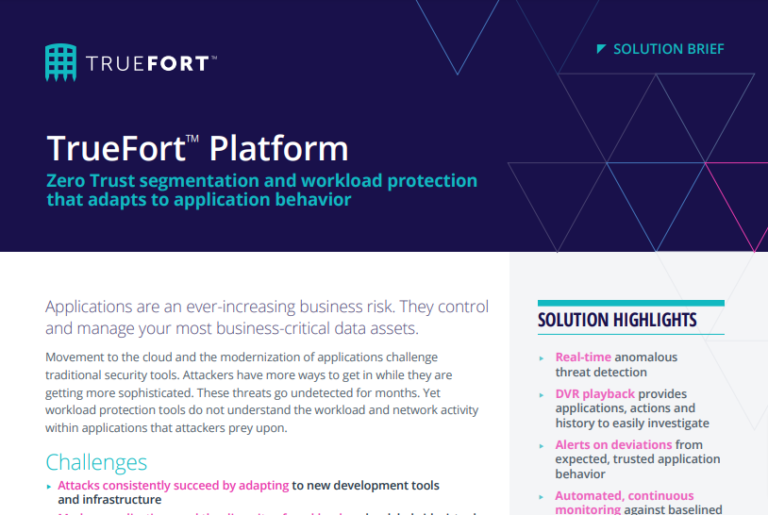TRUEFORT PRODUCT
CIS Benchmarking for System Hardening Best Practices
Most security teams are burdened with open-source tools or periodic vulnerability scans to drive best practices for system hardening. TrueFort‘s adaptive profiling enables security teams to shift to continuously validated configuration against CIS benchmarks so risks don’t creep into the environment.
TRUEFORT PRODUCT
CIS Benchmarking for System Hardening Best Practices
Most security teams are burdened with open-source tools or periodic vulnerability scans to drive best practices for system hardening. TrueFort‘s adaptive profiling enables security teams to shift to continuously validated configuration against CIS benchmarks so risks don’t creep into the environment.
Workload hardening is foundational yet harder in hybrid environments
- Drift from initial configurations – server workload configurations are often confirmed at creation and change without notice.
- Periodic risk introduction – system vulnerabilities and misconfigurations frequently introduce new risks and vulnerabilities over time.
- Unknown risk posture – Effective risk management requires constant visibility into vulnerable software, infrastructure, and abnormal behavior.
- Unable to prove compliance – audits require immediate evidence and planning around security gaps based on policy, state and behavior.

A continuous verification of system state must span old and new
Compliance and Industry Mandates
Applications, systems and infrastructure can be continuously monitored and managed for user-defined policies and industry mandate, (CIS benchmarks, NIST, PCI, NYDFS, etc.)
Automated Pro-active Tuning
Continually pen-testing systems, automatically assessing and detecting the risk posture, notifying teams of changes.
Continuous Verification
Extensive native rule packs and policies enable security teams to verification an application’s hardening status is maintained in a secure state and brought back into compliance if it deviates.
Application-specific Detection and Notification
Data, network access and configuration parameters are monitored against a trusted baseline of normal behaviors, alerting teams of deviations and changes.
FAQ
The Center for Internet Security (CIS) is an international organization of cybersecurity experts who work together to develop benchmarks, a set of standards and best practices, for preventing, detecting, and remediating modern threats. The benchmarks include configuration baselines, controls, and hardened images which help security teams assess and improve their practices and policies.
The benchmarks are categorized into two levels. Level 1 is designed for essential basic security which can be used in most environments and has little impact on operations. Level 2 enumerates settings for more stringent protections which may restrict some business functions. CIS controls work in concert with regulatory requirements and standards, including the NIST Cybersecurity Framework (CSF) and HIPAA.
CIS benchmarks are developed by security experts from a wide variety of organizations and governments. The benchmarks reflect their deep experience in countering cyber threats. The standards are designed so that any organization from small to large can effectively implement reliable security while maintaining normal operations.
Security teams can implement each recommendation or use them to assess existing policies and fill in gaps where needed. With controls addressing software and hardware inventory and configuration, administrative privileges, log monitoring, email and web browser protections, and malware defenses, among others, organizations who are compliant with CIS benchmarks will know they’ve implemented world class security.
Workload hardening involves finding vulnerabilities such as unpatched software, unsafe configurations, or hardcoded secrets then making changes to fix them and reduce the attack surface of a workload. Hardening is particularly important for hybrid workloads because in these environments, information may travel across multiple clouds, on-premise services, through multiple applications and data storage. Accordingly, they are difficult to monitor and can introduce new vulnerabilities to a network.
In the cloud, organizations can spin up workloads that aren’t properly secured or configured. But they still need best-in-class protection which often requires special tools designed for cloud and hybrid environments.










